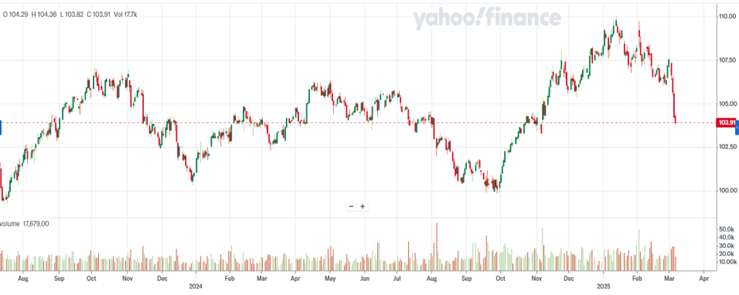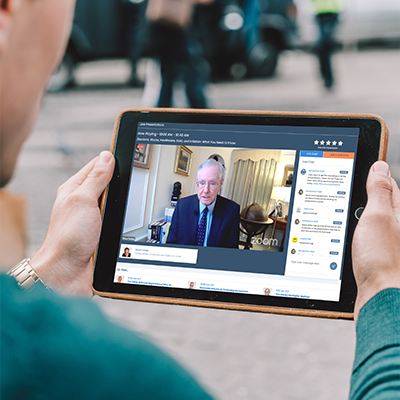- MoneyShow's Trading Insights
- Posts
- TI 03/10/25
TI 03/10/25

Mike Larson | Editor-in-Chief
The US dollar is diving – and savvy traders can capitalize on the trend.
Here is my MoneyShow Chart of the Day showing ICE US Dollar Index futures. You can see how the index topped out near 110 back in mid-January...but has free-fallen all the way to 103.8 since then.
Dollar Index Breaking Down

What’s going on? The dollar initially rallied strongly after President Trump was elected. Investors figured the US economy would outperform foreign economies, US stocks would outperform foreign stocks, and money would flow to the US from other markets around the world.
But in the last two months, it has been a whole different ball game. Trump’s aggressive tariff plans are spooking some investors, leading them to move money elsewhere. US employment and spending data has also softened, helping drive US yields down. Relative interest rates are a key currency driver, so falling rates in any country tend to push its currency lower.
Leaders in the biggest economy in Europe, Germany, also just announced aggressive spending plans to spur growth. That move piled on by boosting the euro (that currency has a 57.6% weighting in the dollar index futures basket).
Traders can always profit DIRECTLY in forex markets by trading spot currencies, currency futures, or currency options. Plus, there are “lower-octane” ways to capitalize – including currency ETFs that track the value of the dollar index or foreign currencies.
The Invesco DB US Dollar Index Bearish Fund (UDN) rises in value when the greenback falls, for instance. Meanwhile, funds like the ProShares Ultra Euro (ULE) offer modestly higher leverage – targeting a 2% gain for every 1% rise in the euro against the buck.
Another option: Buy more foreign stocks or funds that hold them. When foreign currencies rise against the dollar, US-based investors get a currency “kicker” to their returns.
Regardless of which path you choose as a trader, though, do NOT ignore this development. The technical damage to the dollar index is real – and so are the implications for markets!
Nearly five years ago, the COVID-19 pandemic reshaped the world in ways few could have imagined. Lockdowns, economic turmoil, and unprecedented government interventions sent shockwaves through financial markets, forcing investors and policymakers to navigate one of the most volatile economic periods in modern history.
But what if the pandemic’s economic impact is far from over? What if its shadow lasts for decades, just as we’ve seen with past pandemics? In this MoneyShow MoneyMasters Podcast episode, David Kotok, co-founder and chief investment officer of Cumberland Advisors, joins us to discuss his latest book, The Fed and the Flu.
He unpacks how pandemics and economic shocks have reshaped markets, interest rates, and central bank policy over centuries — and what investors can expect moving forward. Drawing from 3,800 years of history, Kotok reveals the hidden patterns of pandemics, the long-term market shifts they create, and why investors who ignore these cycles do so at their own peril.
To learn from experts like David, join us for the 2025 MoneyShow Masters Symposium Miami, happening May. 15-17 at the Hyatt Regency Miami. Click here to register.
ESLT: A Defense Systems Name That Triggered a Trend Seeker Buy
👉️ TICKER: ESLTElbit Systems Ltd. (ESLT) develops and supplies a portfolio of airborne, land, and naval defense systems and products. Since Barchart’s Trend Seeker signaled a buy on Feb. 26, the stock has gained around 12.1%, notes Jim Van Meerten, analyst at Barchart.
Gold: Two Ways to Think About its Recent Trading Pattern
👉️ TICKER: GLDGold has been very resilient over the last several weeks. The current range has a much narrower amplitude than those posted over the last year. There are two ways of thinking about it, observes Eoin Treacy, editor of Fuller Treacy Money.
What did you think of today's newsletter? |




